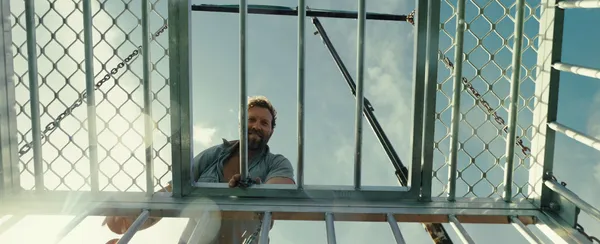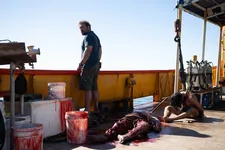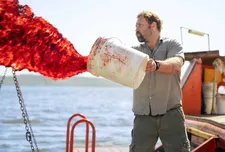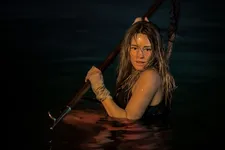 |
| Dangerous Animals Photo: courtesy of Independent Film Company and Shudder. An Independent Film Company and Shudder Release. |
Ten years after the haunted house and possession horror The Devil's Candy (2015), Tasmanian director Sean Byrne returns with Dangerous Animals (2025). The story follows Zephyr (Hassie Harrison), a surfer who lives to ride the waves. She refuses to trust anyone enough to be vulnerable and never stays put in one place for too long — as rejected one-night stand Moses Markley (Josh Heuston) learns. When she is abducted by tugboat captain Tucker (Jai Courtney), she must escape the ritualistic fate of being fed to the sharks and confront her demons.
The theme of abduction is a thread that runs through Byrne's feature début The Loved Ones (2009) and Dangerous Animals, despite the latter being a script written by Nick Lepard. Instead of a maniacal sailor who likes feeding tourists to the sharks, Byrne's earlier film follows high school student Lola's violently twisted response to classmate Brent's refusal to go to the prom with her. Tucker and Lola are characters responding to something from either their distant or near pasts, and similarly to Zephyr, both are broken souls. Meanwhile, The Devil's Candy sits between the two with Byrne exploring a different kind of story, infused with metal music, in which a painter is possessed by an evil spirit.
 |
| Dangerous Animals Photo: courtesy of Mark Taylor. An Independent Film Company and Shudder Release. |
In conversation with Eye For Film, Byrne discussed testing his heroine's will to survive and keeping ahead of his audience. He also reflected on the influence of not only cinema but sport, the space horror lives in, and giving the shark a chance for redemption.
Paul Risker: Where does Dangerous Animals sit within your filmography?
Sean Byrne: It shares a similar theme in that your pain can either be your saviour, or it can drive you off a cliff [laughs]. Dangerous Animals is similar to The Loved Ones, in which Brent's pain is his saviour.
Zephyr has had a difficult upbringing that has left her with this broken life. And her past traumas give her this armour that allows her to overcome this incredibly intimidating obstacle in the form of Tucker, the tugboat captain.
Both Zephyr and Tucker are broken people, but his brokenness drives him off a cliff. He tries to fill a philosophical void by feeding his victims to the sharks because of something that happened in his childhood.
Visually, my films are all pretty similar. They're all kind of sleek and cinematic, which balances out the darkness, and I think they're all extremely attacking. But I never want my films to feel like an ordeal — they are extreme, but they are extreme fun.
PR: To be able to move forward, it's sometimes necessary to confront our demons or, philosophically speaking, stare into the abyss. This is part of Dangerous Animals' subtext, but on its surface, it remains an entertaining shark-based horror. Balancing those two forces must have been an important consideration?
 |
| Dangerous Animals Photo: courtesy of Mark Taylor. An Independent Film Company and Shudder Release. |
SB: Absolutely! I'm a huge Rocky fan, and I'm a big believer that the more a lead can earn their survival, the more aspirational it is for the audience, because we're in Zephyr's shoes. We want to feel like she deserves to get out, or she should have gotten out, but she hasn't, and it is so unfair.
But you just never give up and that's something that has always resonated in films — you just keep going, and it's the same in sport. You watch Federer versus Nadal, where it's 12-11 in the fifth set, and they're surviving on fumes — there's something so heroic about that. I'm as influenced by sport as I am by cinema, but yeah, I feel that is something that's very moving for an audience.
There's also a lot of other messaging here about shark conservation and I think this is the first shark film where the sharks aren't the baddies, which is long overdue.
PR: Do you see Dangerous Animals as a cynical film about human beings and how we are more savage and crueller than nature's predators that pique our interest and at the same time terrify us?
SB: Absolutely, and this very clearly says that the creatures that lurk below, that we've been trained to think are one of our primary fears, aren't really where we should be looking at all. Instead, we need to look into the dark heart of man, who is the true monster.
PR: Films such as Dangerous Animals are manipulating the audience's emotions by playing on their hope the character will outwit, escape or survive the captor, stalker or killer. It occurs to me that hope is integral to building suspense in horror.
 |
| Dangerous Animals Photo: courtesy of Mark Taylor. An Independent Film Company and Shudder Release. |
SB: Hope is where horror lives. It's in that great space between life and death, and there's nothing more dramatic than that. So, I just try and milk those moments, because if you are abducted, all you've got is your will to live. I wanted to test that as much as possible because, as we mentioned before, if a character can earn their survival and the audience are in their shoes, then they leave feeling uplifted and that they can take on the world.
The greatest opportunity with horror is that, as I say, it lives between life and death, and theoretically, there is nothing more dramatic than that. It's why it's my favourite genre and if you care about those characters that are in peril, then you have the most searing form of drama possible. And that's why I feel like it's sometimes a waste in horror films when it's all about the kills. It's not really about the kills, because they are meaningless unless you care about the characters. If you do, then the kills will shake you to your foundations.
PR: The effectiveness of films like yours and traditionally the slasher sub-genre relies on the audience projecting themselves onto the film. As an audience, we are in search of a primal experience that allows us to reconnect with our primitive past and the struggle to survive.
SB: It's primal, and if you're abducted and removed from land where no one can hear you scream, just like in space, it's gladiatorial in the most personal sense. And I guess everyone wonders about what they're made of when it comes down to that. But I also think it's incredibly cathartic to experience that with an audience and to live out your fears in the dark and scream together. Then you walk out into the light of day and everything's all right compared to what you've just seen.
PR: The lynchpin in creating an entertaining experience rather than the ordeal you mentioned in your opening answer, is the pacing and rhythm of Zephyr and Tucker's back and forth struggle.
SB: It's important that the first act is character building, because if you don't establish that connection with the characters, then the rest of it doesn't work.
 |
| Dangerous Animals Photo: courtesy of Mark Taylor. An Independent Film Company and Shudder Release. |
I love roller coasters, but a huge part of the enjoyment is the expectation of chugging up the hill. So, it's about trying to put loops in places that the audience aren't necessarily expecting and to use the whole horror director's toolkit. If the horror is always shouting at you and the sound design and score are telling you what's going to happen, then you can start to get ahead of it. But if you can blend it with some Michael Haneke objectivity, where you take everything away and the characters are left helpless, then that's one way of changing things up.
There's almost a Groundhog Day (1993) quality to this film where there are three central scenes on a crane, but they are all incredibly different. In the first one, we've created this anticipation, and we tease the audience who don't know what's going to happen. In the second one, they do know what's going to happen, and that has more of a Michael Bay kinetic action feel, where it's completely unstoppable. And the third one is the heroine finally meeting her destiny. If those three felt the same, then the audience would have thought, well, I've already been here, so, what's the point? And audiences are so smart that they'll second guess you, and so, you've got to at least third guess or fourth guess them.
Dangerous Animals is released theatrically in the US by IFC Films and Shudder, and in the UK by Vertigo Releasing on June 6th.





















